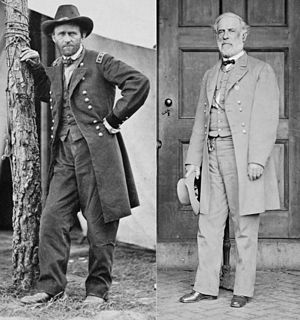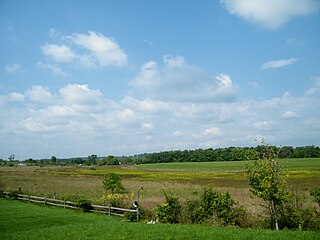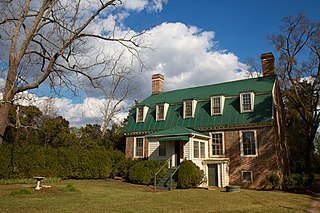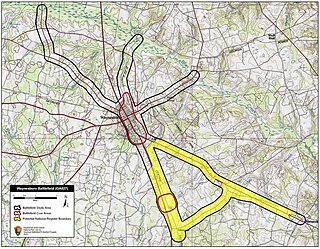
The Richmond–Petersburg campaign was a series of battles around Petersburg, Virginia, fought from June 9, 1864, to March 25, 1865, during the American Civil War. Although it is more popularly known as the siege of Petersburg, it was not a classic military siege, in which a city is usually surrounded and all supply lines are cut off, nor was it strictly limited to actions against Petersburg. The campaign consisted of nine months of trench warfare in which Union forces commanded by Lt. Gen. Ulysses S. Grant assaulted Petersburg unsuccessfully and then constructed trench lines that eventually extended over 30 miles (48 km) from the eastern outskirts of Richmond, Virginia, to around the eastern and southern outskirts of Petersburg. Petersburg was crucial to the supply of Confederate Gen. Robert E. Lee's army and the Confederate capital of Richmond. Numerous raids were conducted and battles fought in attempts to cut off the Richmond and Petersburg Railroad. Many of these battles caused the lengthening of the trench lines.

The Vicksburg campaign was a series of maneuvers and battles in the Western Theater of the American Civil War directed against Vicksburg, Mississippi, a fortress city that dominated the last Confederate-controlled section of the Mississippi River. The Union Army of the Tennessee under Major General Ulysses S. Grant gained control of the river by capturing this stronghold and defeating Lieutenant General John C. Pemberton's forces stationed there.

The Battle of Resaca, from May 13 to 15, 1864, formed part of the Atlanta Campaign during the American Civil War, when a Union force under William Tecumseh Sherman engaged the Confederate Army of Tennessee led by Joseph E. Johnston. The battle was fought in Gordon and Whitfield Counties, Georgia, and is generally viewed as inconclusive.

The Atlanta campaign was a series of battles fought in the Western Theater of the American Civil War throughout northwest Georgia and the area around Atlanta during the summer of 1864. Union Maj. Gen. William Tecumseh Sherman invaded Georgia from the vicinity of Chattanooga, Tennessee, beginning in May 1864, opposed by the Confederate general Joseph E. Johnston.

The Battle of Peachtree Creek was fought in Georgia on July 20, 1864, as part of the Atlanta Campaign in the American Civil War. It was the first major attack by Lt. Gen. John Bell Hood since taking command of the Confederate Army of Tennessee. The attack was against Maj. Gen. William T. Sherman's Union army, which was perched on the doorstep of Atlanta. The main armies in the conflict were the Union Army of the Cumberland, commanded by Maj. Gen. George Henry Thomas and two corps of the Confederate Army of Tennessee.

The Battle of New Bern was fought on 14 March 1862, near the city of New Bern, North Carolina, as part of the Burnside Expedition of the American Civil War. The US Army's Coast Division, led by Brigadier General Ambrose Burnside and accompanied by armed vessels from the North Atlantic Blockading Squadron, were opposed by an undermanned and badly trained Confederate force of North Carolina soldiers and militia led by Brigadier General Lawrence O'B. Branch. Although the defenders fought behind breastworks that had been set up before the battle, their line had a weak spot in its center that was exploited by the attacking Federal soldiers. When the center of the line was penetrated, many of the militia broke, forcing a general retreat of the entire Confederate force. General Branch was unable to regain control of his troops until they had retreated to Kinston, more than 30 miles away. New Bern came under Federal control, and remained so for the rest of the war.

The Overland Campaign, also known as Grant's Overland Campaign and the Wilderness Campaign, was a series of battles fought in Virginia during May and June 1864, in the American Civil War. Lt. Gen. Ulysses S. Grant, general-in-chief of all Union armies, directed the actions of the Army of the Potomac, commanded by Maj. Gen. George G. Meade, and other forces against Confederate Gen. Robert E. Lee's Army of Northern Virginia. Although Grant suffered severe losses during the campaign, it was a strategic Union victory. It inflicted proportionately higher losses on Lee's army and maneuvered it into a siege at Richmond and Petersburg, Virginia, in just over eight weeks.

Drewry's Bluff is located in northeastern Chesterfield County, Virginia in the United States. It was the site of Confederate Fort Darling during the American Civil War. It was named for a local landowner, Confederate Captain Augustus H. Drewry, who owned the property.

The Second Battle of Kernstown was fought on July 24, 1864, at Kernstown, Virginia, outside Winchester, Virginia, as part of the Valley Campaigns of 1864 in the American Civil War. The Confederate Army of the Valley under Lt. Gen. Jubal A. Early soundly defeated the Union Army of West Virginia under Brig. Gen. George Crook and drove it from the Shenandoah Valley back over the Potomac River into Maryland. As a result, Early was able to launch the Confederacy's last major raid into northern Union territory, attacking the Baltimore and Ohio Railroad in Maryland and West Virginia and burning Chambersburg, Pennsylvania, in retaliation for the burning of civilian houses and farms earlier in the campaign.

The Battle of Sailor's Creek was fought on April 6, 1865, near Farmville, Virginia, as part of the Appomattox Campaign, near the end of the American Civil War. It was the last major engagement between the Confederate Army of Northern Virginia, commanded by General Robert E. Lee and the Army of the Potomac, under the overall direction of Union General-in-Chief Lieutenant General Ulysses S. Grant.

The Battle of Totopotomoy Creek, also called the Battle of Bethesda Church, Crumps Creek, Shady Grove Road, and Hanovertown, was a battle fought in Hanover County, Virginia on May 28–30, 1864, as part of Union Lt. Gen. Ulysses Grant's Overland Campaign against Confederate Gen. Robert E. Lee's Army of Northern Virginia.

The Bermuda Hundred campaign was a series of battles fought at the town of Bermuda Hundred, outside Richmond, Virginia, during May 1864 in the American Civil War. Union Maj. Gen. Benjamin Butler, commanding the Army of the James, threatened Richmond from the east but was stopped by forces under Confederate Gen. P.G.T. Beauregard.

The siege of Corinth was an American Civil War engagement lasting from April 29 to May 30, 1862, in Corinth, Mississippi. A collection of Union forces under the overall command of Major General Henry Halleck engaged in a month-long siege of the city, whose Confederate occupants were commanded by General P.G.T. Beauregard. The siege resulted in the capture of the town by Federal forces.

The Battle of Port Walthall Junction was fought May 6–7, 1864, between Union and Confederate forces during the Bermuda Hundred Campaign of the American Civil War. Although initially successful, the Confederates were eventually defeated, allowing Union forces to cut a railroad. The Port Walthall Junction on the Richmond-Petersburg Railroad connected with the spur to Port Walthall.
The Battle of Chester Station was fought on May 10, 1864, between Union and Confederate forces during the American Civil War. The Confederates attacked portions of Benjamin Butler's Union forces.
The Battle of Proctor's Creek -- also referred to as Drewry's Bluff or Fort Darling -- was fought from May 12 to May 16, 1864, in Chesterfield County, Virginia, during the Bermuda Hundred Campaign of the American Civil War. Proctor's Creek was named for Charles Proctor, who lived and farmed on the land surrounding most of the creek.
The Battle of Kolb's Farm was fought on June 22, 1864, between Union forces under Maj. Gen. Joseph Hooker and Confederate forces under Lt. Gen. John B. Hood. Hood attempted an attack on the Union force, but poor terrain conditions led to its failure.

The Battle of Waynesboro was an American Civil War battle fought on December 4, 1864 in eastern Georgia, towards the end of Sherman's March to the Sea. Union cavalry forces under Brig. Gen. Judson Kilpatrick defeated Confederate cavalry led by Maj. Gen. Joseph Wheeler, opening the way for William T. Sherman's armies to approach their objective, Savannah.

The Battle of Sappony Church, also known as the Battle of Stony Creek Depot, was an engagement of the American Civil War, between the Confederate States of America and the Union, which took place on June 28, 1864, during the Wilson-Kautz Raid of the Richmond–Petersburg Campaign.

The Battle of Georgia Landing was fought October 27, 1862 in Labadieville, Assumption Parish, Louisiana, as part of the Operations in LaFourche District (1862), during the American Civil War.


















